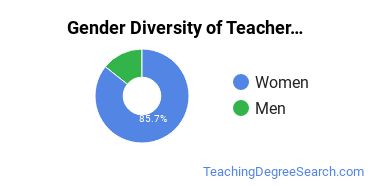Teacher Education Grade Specific at University of Alaska Fairbanks
Every teacher education grade specific school has its own distinct culture and strengths. We've pulled together some statistics and other details to help you see how the grade specific ed program at University of Alaska Fairbanks stacks up to those at other schools.UAF is located in Fairbanks, Alaska and has a total student population of 6,813.
Want to know more about the career opportunities in this field? Check out the Careers in Teacher Education Grade Specific section at the bottom of this page.
UAF Teacher Education Grade Specific Degrees Available
- Undergrad Certificate in Grade Specific Ed (1 - 4 Years)
- Associate’s Degree in Grade Specific Ed
- Bachelor’s Degree in Grade Specific Ed
UAF Teacher Education Grade Specific Rankings
The grade specific ed major at UAF is not ranked on College Factual’s Best Colleges and Universities for Teacher Education Grade Specific. This could be for a number of reasons, such as not having enough data on the major or school to make an accurate assessment of its quality.
Grade Specific Ed Student Demographics at UAF
Take a look at the following statistics related to the make-up of the grade specific ed majors at University of Alaska Fairbanks.
UAF Teacher Education Grade Specific Associate’s Program

UAF does a better job with serving racial-ethnic minorities than the typical school does. Its associate's program in grade specific ed graduates 22% more racial-ethnic minorities than the nationwide average.*
The following table and chart show the race/ethnicity for students who recently graduated from University of Alaska Fairbanks with a associate's in grade specific ed.

| Race/Ethnicity | Number of Students |
|---|---|
| Asian | 0 |
| Black or African American | 0 |
| Hispanic or Latino | 1 |
| White | 1 |
| International Students | 0 |
| Other Races/Ethnicities | 7 |
UAF Teacher Education Grade Specific Bachelor’s Program

Prospective students may be interested in knowing that this school graduates 14% more racial-ethnic minorities in its grade specific ed bachelor's program than the national average.*
The following table and chart show the race/ethnicity for students who recently graduated from University of Alaska Fairbanks with a bachelor's in grade specific ed.

| Race/Ethnicity | Number of Students |
|---|---|
| Asian | 0 |
| Black or African American | 0 |
| Hispanic or Latino | 1 |
| White | 10 |
| International Students | 0 |
| Other Races/Ethnicities | 10 |
Concentrations Within Teacher Education Grade Specific
If you plan to be a grade specific ed major, you may want to focus your studies on one of the following concentrations. The table shows all degrees awarded in this field awarded for all degree levels at University of Alaska Fairbanks. A concentration may not be available for your level.
| Concentration | Annual Degrees Awarded |
|---|---|
| Elementary Education | 37 |
| Early Childhood Education | 14 |
| Secondary Education | 12 |
Related Majors
Careers That Grade Specific Ed Grads May Go Into
A degree in grade specific ed can lead to the following careers. Since job numbers and average salaries can vary by geographic location, we have only included the numbers for AK, the home state for University of Alaska Fairbanks.
| Occupation | Jobs in AK | Average Salary in AK |
|---|---|---|
| Elementary School Teachers | 3,870 | $74,070 |
| High School Teachers | 2,380 | $77,920 |
| Middle School Teachers | 1,370 | $75,770 |
| Preschool Teachers | 940 | $36,210 |
| Self-Enrichment Education Teachers | 570 | $54,240 |
References
*The racial-ethnic minorities count is calculated by taking the total number of students and subtracting white students, international students, and students whose race/ethnicity was unknown. This number is then divided by the total number of students at the school to obtain the racial-ethnic minorities percentage.
- College Factual
- National Center for Education Statistics
- O*NET Online
- Image Credit: By Burntorange72 under License
More about our data sources and methodologies.
